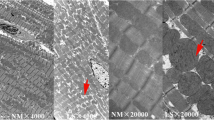Abstract
Dietary selenium deficiency represents an etiological factor in “Keshan disease”, a distinct form of an endemic cardiomyopathy. The biochemical effects of selenium depletion in the myocardium are, however, not yet known. Therefore, we investigated the changes in the myocardial protein pattern in rats after long-term selenium deficiency.
The myocardial proteins were analyzed in samples from five selenium-depleted rats (Se-deficient group) and five rats supplied with adequate amounts of the element (Se-adequate group). Isoelectric focusing (IEF) with carrier ampholytes on large 2-DE gels was used for the separation of proteins in the first dimension and sodium dodecyl sulfate-polyacrylamide gel electrophoresis (SDS-PAGE) for the second dimension. The protein patterns were evaluated by means of a computer-assisted gel analysis system. The biochemical identification of the proteins of interest was achieved by matrix-assisted laser desorption/ionization mass spectrometry (MALDI) or immunoblotting.
On average, 588 ± 68 protein spots were found on the gels. No significant difference in spot numbers existed between the groups. A pattern of 270 spots with identical positions was found on every gel; 247 of these spots were not saturated and used for quantitative comparison. Thirty-five, i. e., 14%, differed significantly in their relative intensity in the two groups. Twenty-eight protein spots were decreased in the Se-deficient group and seven were increased. Sarcomeric creatine kinase M chain, α-myosin heavy chain (α-MHC) and myosin light chain 1 and 2 (MLC 1 and 2) were largely decreased in Se-deficiency. Three protein spots were increased by more than twofold or appeared only in the Se-deficient group. A mitochondrial creatine kinase was identified in this group.
The results suggest that selenium deficiency affects myocardial energy metabolism and contractile proteins. These changes probably reflect non-specific alterations in heart failure.
Similar content being viewed by others
Author information
Authors and Affiliations
Additional information
Received: 19 February 1997, Returned for 1. revision: 7 April 1997, 1. Revision received: 29 January 1999, Returned for 2. revision: 18 February 1999, 2. Revision received: 21 December 1999, Accepted: 6 January 2000
Rights and permissions
About this article
Cite this article
Regitz-Zagrosek, V., Kyriakopoulos, A., Pleißner, KP. et al. Effects of selenium deficiency on the rat myocardial protein pattern – investigation by two-dimensional gel electrophoresis. Basic Res Cardiol 95, 199–207 (2000). https://doi.org/10.1007/s003950050182
Issue Date:
DOI: https://doi.org/10.1007/s003950050182




